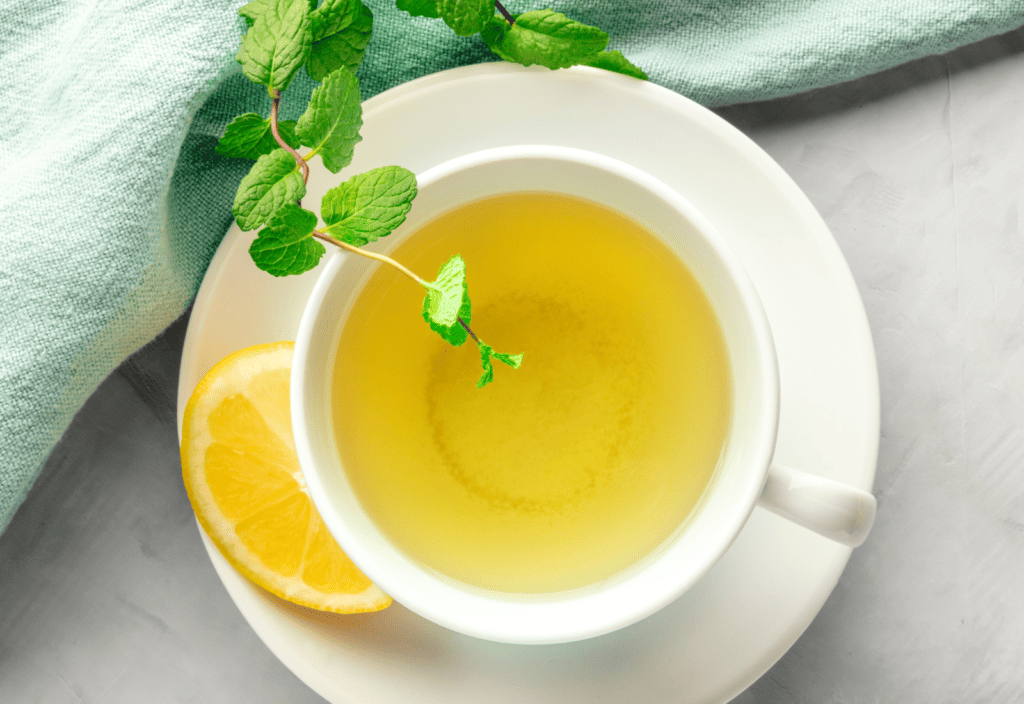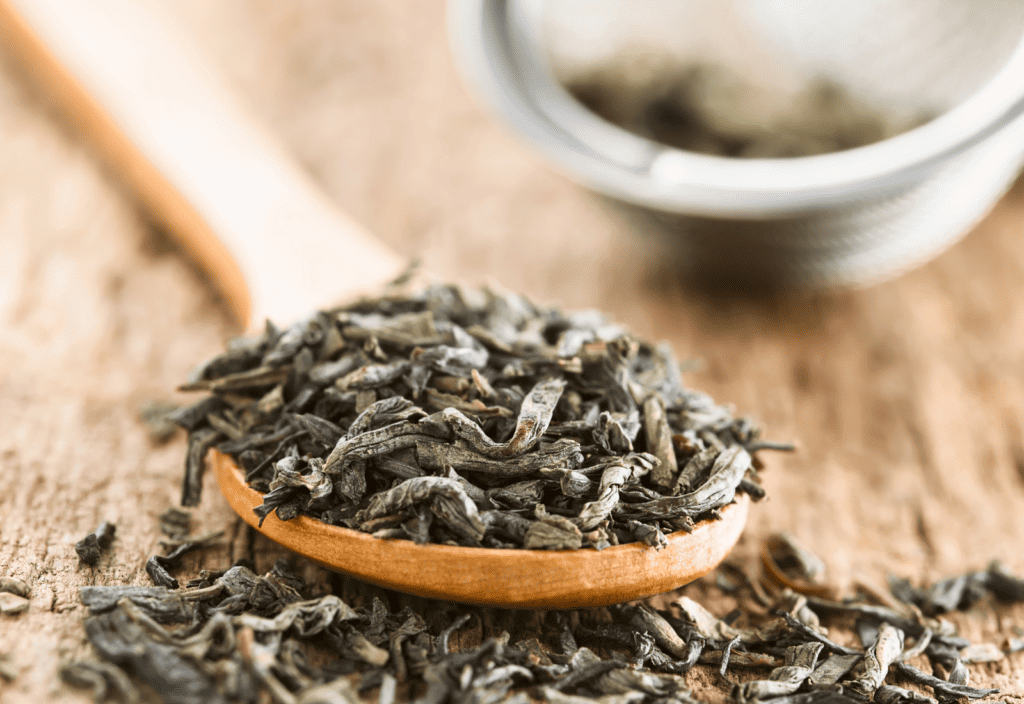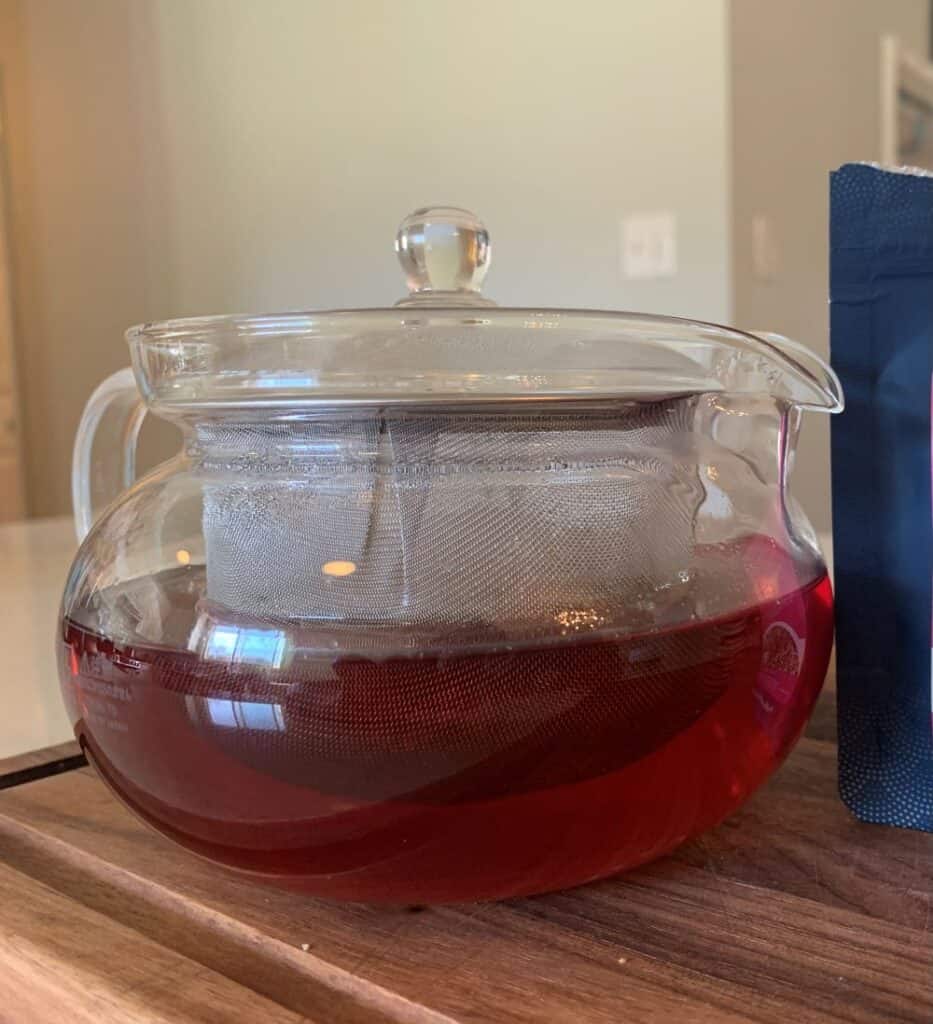Unless you grew up in a culture that drinks green tea regularly, you have likely struggled with the taste of plain green tea. I know I have! Hopefully, this post will give you some ideas about how to make green tea taste good without sugar.

This post contains affiliate links. At no cost to you, I may earn a small commission on qualifying purchases. Thank you! Your support makes this blog possible.
What are the Best Flavors to Add to Green Tea?
To get right to it, you can make green tea taste good without sugar by adding flavors like mint, lemon, hibiscus, peach or raspberry to it. You can do this by adding the actual fruit/plant or by mixing other types of tea with green tea.
If you’re drinking green tea for health benefits, you likely don’t want to add much or any sugar to it. Luckily, there are many ways to enhance and improve the flavor without adding sugar. When I first learned about the health benefits of green tea, I did the “fake it until you make it” method.
My plan was simply to acquire a taste for plain green tea. I can be a pretty persistent person and realize this strategy won’t work for everyone, but I will say it was an effective strategy for me.
While drinking it plain is not my favorite way to drink green tea, I can still manage to down a mug of plain green tea.
Some Health Benefits of Green Tea
While this post is not about the benefits of green tea, it’s hard not to at least highlight a few. Green tea is one of the most powerful foods/beverages we have at our disposal to prevent and fight disease.
- Energy Booster/Focus
- Cardiovascular and Metabolic Diseases
- Acne Fighter
- Stress Reducer
- Immune Support
- Allergy Aid
There are actually even more benefits than that! You can read my related green tea post for more details on the benefits of green tea. Or if you’re already sold on green tea, just keep reading as we discuss how to make green tea taste good without sugar.
How to Add Flavors to Green Tea
Mint and Lemon are two of the popular flavors that you see blended with green tea. You can add a few slices of lemon to your hot or cold green tea or a couple of mint leaves, which you can easily grow or pick up in the produce section of the grocery store.
Here’s neat video that shows you how to grow mint in your home year-round.
Raspberry, hibiscus and peach also pair well with green tea and are my personal favorites. You can always infuse your green tea with the fruits or simply toss some berries into your brewed tea if you don’t have a diffuser.
If you desire more sweetness to your tea, honey or pure Stevia can be healthier options to traditional sugar. If you buy Stevia or monk fruit sweetener, just be sure to check the ingredient label to be sure you aren’t getting any surprises.
Other Teas That Pair Well with Green Tea
You may have wondered what other tea flavors go well with green tea. The tea flavors mentioned above, mint and lemon, will obviously work and my personal favorites, the fruity ones!
Hibiscus, peach and raspberry teas are my favorite to combine with green tea. If you are using loose leaf tea, you’ll add those tea leaves to your tea pot.
If you are using store bought tea bags, simply add an extra tea bag to your mug. It’s pretty simple! You can experiment with different flavors to find what you like most.
Is Loose Leaf Tea Healthier Than Tea Bags?
I utilized tea bags for many years as a working mom of young children. I needed to be able to make the tea at work, and I just didn’t have time for one more thing on my plate.
Now that I work from home, I brew loose leaf tea and believe it may be slightly healthier than tea bags. Some believe loose leaf tea is fresher, less processed and may even contain higher amounts of antioxidants and bioactive compounds.
However, I have not been able to find any really good sources proving this to be true. As with most topics, it likely depends on several factors.

Brewing loose leaf tea is definitely more sustainable than using tea bags as it requires much less packaging. It is also usually a cheaper long-term option.
What to Look for in Tea Bags
If you go the tea bag route, there are several things to look for to ensure you are getting a high quality tea. For example, you want to shop for USDA organic tea that comes in unbleached, natural tea bags.
Tea crops can be a heavily sprayed, and teas are often imported from China or other countries where quality checks are not always top notch. You want to buy teas from a reputable brand and buy organic whenever possible.
You also want to be sure the tea is not in bleached tea bags that contain microplastics (just eww!). Most reputable organic tea brands will steer clear of these practices but not always, You may have to do a little research to confirm what the tea bags are made of.
Studies show that when you brew tea bags containing plastic that thousands of microplastics release into the cup of tea. This kind of defeats the purpose of drinking green tea in the first place.
One tell-tale sign of cheap tea bags is if they are bright white—this means they are definitely bleached. Natural tea bags should be off white or beige in color. Sometimes you can find the tea bag material in the product description online but rarely will it be listed on a tea box in the grocery store.
Best Store-Bought Green Tea Bags
One of my favorite brands for green tea bags is Numi, which offers fair-trade organic tea in non-GMO manila hemp cellulose tea bags. Numi also carries loose leaf green tea.
Traditional Medicinals is another trustworthy tea brand that is widely available. Per their website, their compostable tea bags consist of wood pulp and manila hemp (same as Numi). Their tea bags do not contain any plastics.
Best Loose-Leaf Green Tea
This year, I have started ordering from Full Leaf Tea Co. I did quite a bit of research beforehand and feel they are one of the most trustworthy sources for tea. My favorite combinations so far are the Organic Hibiscus or the Very Berry Bunch (not organic, unfortunately) with the Organic Green Sencha.
Of the Full Leaf Tea Co. preblended teas, the Organic Passion Tea is my favorite. It contains lemon, hibiscus and green tea. They have recently added organic peach green tea, which is being shipped to me as I write this update.
As soon as I try it, I’ll report back on the taste.
Mountain Rose Herb is also a great source for teas, but they were having supplier issues the last time I tried to place an order.
What You Need to Brew Loose Leaf Tea
Hario Glass Teapot
I am a proud owner this sweet little Japanese Hario Glass Teapot and absolutely love it. It makes enough tea for two or maybe three small glasses of tea. Admittedly, when I ordered it, I thought it could be used on the stovetop as some glass teapots can, but it is too dainty for that.

You will need a stainless-steel kettle to heat water and pour into the Hario teapot, but it’s still a fairly simple process. I use a kettle daily for coffee, so I did not have to purchase one just for this.
Stainless Steel Tea Kettle
My splurge option for a stainless-steel tea kettle is this All-Clad stainless steel tea kettle. While I have not splurged on one just yet, All-Clad is known for its longevity. Because of this, I believe this tea kettle would be a great investment piece.
A budget-friendly stainless-steel kettle is the Hario Drip Kettle, which is lead free and made in Japan. I am a fan of the Hario brand hints my little glass teapot above!
The Wrap Up
All is not lost if you don’t love the taste of plain green tea! There are lots of options to enhance the taste and make it at least tolerable for you if not enjoyable.
Again, my personal favorite method to make green tea taste good without sugar is to brew a fruity tea like hibiscus, peach or raspberry tea and combine it with green tea!
If it works for this southern girl, it just may work for you. I’m pretty sure I’m one of maybe ten ladies in the entire state of Tennessee who prefers unsweet tea to sweet tea!
How do you drink your green tea? Let me know in the comments.